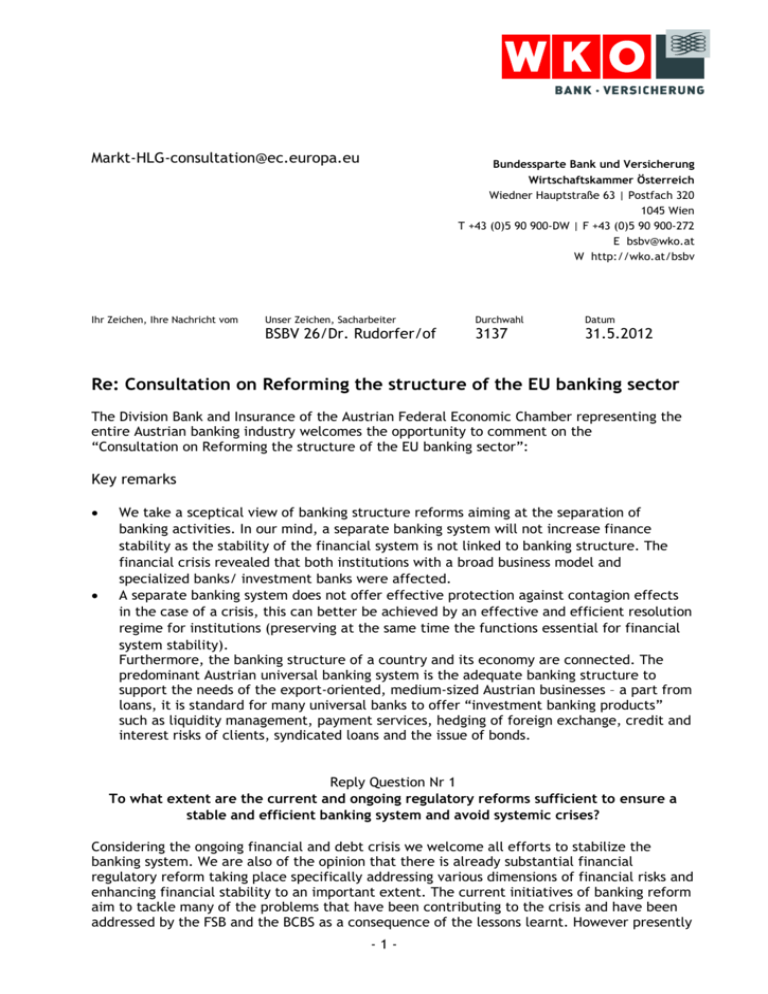Austrian federal econom chamber
advertisement

Markt-HLG-consultation@ec.europa.eu Ihr Zeichen, Ihre Nachricht vom Bundessparte Bank und Versicherung Wirtschaftskammer Österreich Wiedner Hauptstraße 63 | Postfach 320 1045 Wien T +43 (0)5 90 900-DW | F +43 (0)5 90 900-272 E bsbv@wko.at W http://wko.at/bsbv Unser Zeichen, Sacharbeiter Durchwahl Datum BSBV 26/Dr. Rudorfer/of 3137 31.5.2012 Re: Consultation on Reforming the structure of the EU banking sector The Division Bank and Insurance of the Austrian Federal Economic Chamber representing the entire Austrian banking industry welcomes the opportunity to comment on the “Consultation on Reforming the structure of the EU banking sector”: Key remarks We take a sceptical view of banking structure reforms aiming at the separation of banking activities. In our mind, a separate banking system will not increase finance stability as the stability of the financial system is not linked to banking structure. The financial crisis revealed that both institutions with a broad business model and specialized banks/ investment banks were affected. A separate banking system does not offer effective protection against contagion effects in the case of a crisis, this can better be achieved by an effective and efficient resolution regime for institutions (preserving at the same time the functions essential for financial system stability). Furthermore, the banking structure of a country and its economy are connected. The predominant Austrian universal banking system is the adequate banking structure to support the needs of the export-oriented, medium-sized Austrian businesses – a part from loans, it is standard for many universal banks to offer “investment banking products” such as liquidity management, payment services, hedging of foreign exchange, credit and interest risks of clients, syndicated loans and the issue of bonds. Reply Question Nr 1 To what extent are the current and ongoing regulatory reforms sufficient to ensure a stable and efficient banking system and avoid systemic crises? Considering the ongoing financial and debt crisis we welcome all efforts to stabilize the banking system. We are also of the opinion that there is already substantial financial regulatory reform taking place specifically addressing various dimensions of financial risks and enhancing financial stability to an important extent. The current initiatives of banking reform aim to tackle many of the problems that have been contributing to the crisis and have been addressed by the FSB and the BCBS as a consequence of the lessons learnt. However presently -1- we rather see the danger of too many activities in the banking sector legislation which due to time pressure might have unintended consequences such as unintended deleveraging or increased refinancing costs. The CRD IV / CRR will implement new capital requirements to all European banks and is intended to considerably enhance the stability of banks in the EU. The Basel III Accord will certainly contribute to a more sustainable and stable banking structure in Europe. It should be stressed that it seems consequently appropriate to first implement upcoming legislative rules, like CRDIV/CRR, the amendment of the Deposit Guarantee Directive, Crisis Management, just to name the most important, before taking further measures into account. And we must not forget that some reforms have already taken place, like the new European supervisory architecture. Indeed, we consider that it would be stringent to concentrate on the implementation of the current or upcoming regulation which still has to be defined and refined. As a result and once adopted, we deem it appropriate to have a thorough impact analysis of the coherent financial architecture to identify then possibly still existing shortcomings as the next step. We would therefore plead for a step-by-step approach. However, we are concerned about the cumulative impact of the comprehensive reform package under way, not just on one country or one bank but specifically on the CEE region as a whole. Moreover, the upcoming proposal for a Directive on Crisis Management could be the key for a controlled resolution of large complex cross border institutions and therefore for a stable banking system as a whole. Institutions and authorities will be required to draw up recovery and resolution plans for the event of a material deterioration of their financial situation. Furthermore the Crisis Management Directive provides resolution measures when an institution fails and is likely to fail and will enable public authorities to take mandatory measures in case of resolution. We think that the Crisis Management could be a further step to ensure a safe and stable banking sector as it provides effective measures in case of failure whereas in normal times credit institutions are free to choose the most efficient structure and business model. Banks which have invested in a long-term presence in the CEE region, have a safe banking model consisting of deposits and loans for private households and SMEs (classic basic retail banking). The CEE is the only real growth area within the EU, but it is heavily dependent on loans, infrastructure and project finance. Negative repercussions of regulation on the economic potential of this promising region should be avoided, due to the higher dependency on bank loans than in Western Europe (Western Europe: 70% credit financed 30% bond financed, CEE: over 85% credit financed, US: 25% credit financed) the impact on that region will be even higher than for Western Europe. Reply Question Nr 2 Which structural reforms would improve the safety and efficiency of the banking system in the EU in the near term? In the long term? Imposing a regulation on business models/banking structures does in our view not represent adequate measures to prevent financial crises, contagion effects and the use of taxpayer funds – these goals can best be achieved by an adequate management of risks, a solid supervision and an efficient resolution regime. Instead of limiting entrepreneurial freedom by legal interventions, incentives for a better identification and measurement of risks should be provided. Modern, continental European banking business is characterized by a close linkage of customer business and investment banking services, whereby investment banking products -2- serve predominantly concrete customers’ needs, e.g. the hedging of long-term loans with fixed interest rate, capital guarantees for investment products etc. At the European level there a several regulatory reforms in negotiation which aim to prevent systemic risks and try to make the European banking system more safe. We are of the opinion that the ongoing regulatory reforms (CRR/CRD IV, Crisis Management-Directive, more transparency for rating agencies) should be first finalised and after a certain period of time the impacts of these new regulatory standards should be evaluated before a structural reform is hastily decided. Although the Commission provides in its proposals an impact assessment for the future effects of its legislation, the actual consequences of certain provisions may only be evaluated after application of this provision in a certain period of time. Moreover we are of the opinion that there is still a lack of legislation for not regulated financial activities (shadow banks). While in the legislative bodies had focused on the regular banking sector and made different proposals for bank regulation, there are still not sufficient rules for the shadow banking sector. Shadow banking has become an integral element for the systemic risk of the financial sector but still these not regulated financial firms and hedge funds are not seriously touched by the latest rules. As long as the regular banking sector remains strongly regulated and there do not exist comparable rules for shadow banks a safe financial system remains an illusion. Regarding the trading volume in the non-banking sector it is not comprehensible that this sector is still insufficiently regulated. Furthermore we see in this unsatisfactory legislative situation the serious threat that certain banking activities will migrate to the shadow banking sector. Therefore we think, before reflecting upon any structural reforms, that an appropriate legislation for shadow banking can contribute to a stable financial system in the near and the long term. We should also take into consideration the cost side and the level playing field issue. We have to take into account that European banks compete at an international as well on a local level with banks of third countries. To establish a fair level playing field is an effective sensitive issue in the context of possible new regulations. Reply Question Nr 3 What are your views on the structural reform proposals to date (e.g. US Volcker Rule, UK ICB proposal)? What would be the implications of these proposals on your institution and the financial system as a whole General remarks The Vickers Report approach may be suitable for the UK banking market, but it does not take into account continental EU banking markets’ specificities. The same is true for the Volckers rule. The European banking structure is based on the universal banking model which entails a comprehensive provision of banking services and a close relation with customers (loans, payments, financial advice, insurances, private banking). The European model of universal banking has survived the crisis quite well compared to other models that focus much more on pure investment banking. We strongly belief that the essence of the universal banking model, the close relation with customers, should remain the same in any further changes that are applied to the EU banking system. Introducing extremely high capital standards for retail banks, which provide the “safer” core banking business, however, produces inverse incentive structures and inefficiencies and may harm financial stability. Banks may be more likely to engage in investment banking than in -3- vital banking services, which contradicts the overall political goal to refocus banking more substantially on their genuine role. US Volcker Rule and the Vickers Report refer to classical group structures where the group holding company is publicly quoted. However the structure of the EU banking sector is diverse and not homogenous. In Europe you find different banking models like banking groups, saving banks, mortgage banks and cooperative banks. All types of banks have their own structure and are not comparable to the others. Most credit institutions are applying the so called “all-finance” concept for its customers. This traditional client-focussed continental European universal banking provides that every single credit institution provides retail services (deposits and loans) and to a lesser extent ancillary services to customers such as derivatives, interest rate swaps, real estate financing or export financing. A bank that provides these services in one entity is more cost efficient for customers, can better diversify its risk exposures and the customers benefit of this onestop-shop model. The diversity of the structure of European banks and the universal bank approach of most of European banks are a strong advantage compared for example to markets with a more fragmented banking sector and where, as a consequence, investment banks have a bigger impact on the economy. We are seriously concerned that the Liikanen group will focus on the “banking sector” without differentiation. The structure of a bank depends on the business model, the size and the risk profile of the institution in question. Between the European banking and more fragmented sectors as well as among European Banks there are important differences regarding business concepts and company models. A “one-model-for-all approach” cannot be the solution for Europe. Consequently we do not think that there is a general concept on how a banking group should be structured in Europe. A separation of retail/commercial banking from investment banking will endanger the service capability of the continental European banking sector, have a negative effect on the fulfilment of customers’ needs and favour the renationalization of the banking sector. In its argumentation the Independent Commission of Banking was clear that the prime driver of the ring-fence of UK banks has less to do with making banks safer and more to do with resolving them if they fail. The question is, however, the resolvability of what is outside the ring-fence – in other words, the complex cross-border investment banking business. Neither the Volcker Rule nor Vicker’s deal with that issue. From our perspective the issue of ring-fencing and resolution of ringfenced banks should be kept separate due to the fact that these are two different issues which should not be confused in that sense that the ring-fencing discussion should be driven by the resolution view only neglecting negative effects in going concern situations. If the ultimate objective of regulatory reform is to get to a position where banks are allowed to fail, and can fail in an orderly fashion, also after implementation of Vickers or Volcker this objective would be still far away. Consequences of the Vickers Report As a consequence the approach of the Vickers Report would break up the entire structure of banks in Europe and would delete well experienced structures in Europe. -4- Moreover according to the Vickers Report banks could pursue all permitted services only within the EEA. This provision could cause serious harm to cross-border banks which are also active in non EU Countries. These banks would have to sell all of its entities outside the European Economic Area even if they only engage in permitted, ringfenced activities. This approach of the Vickers report makes large parts of the traditional client-focussed continental European universal banking largely impossible since it would de facto prevent banks to provide business with non-European Economic Area-subsidiaries or trade and export financings requested by its clients. The implementation of the Vickers Report would result for example in a severe instability of the liquidity flows within decentralised sectors, as cooperative banks would be forced to place surplus liquidity not inside but outside the Sector. This would, inherently, increase the risk exposure of the these sectors. Volcker Rule The implications of a possible regulation such as the so-called Volcker rule (a part of the Dodd-Frank Wall Street Reform and Consumer Protection Act) is more difficult to predict because the concept as discussed in the US is very complex and foresees numerous not yet specified exceptions. The cornerstones of the Volcker rule are as follows: Commercial banks are prohibited to conduct ‘trading a covered financial position in a trading account’. There are a number of exceptions (which are unclear and must still be defined) – however, many banks (like many other banks in Europe) conduct some sort of trading activities part of which might have to be ceased under a regulation of the nature of the Volcker rule. The Volcker Rule prohibits a banking entity from sponsoring or retaining as principal an ownership interest in a covered fund (whereby covered funds include issuers defined as “investment companies” under the Investment Company Act of 1940 (some exemptions) and commodity pools. As it looks, this would hamper the banks’s activities with respect to its asset management companies or, at least, to make investments (eg as seed money) therein. Indirectly, experts estimate that the Volcker rule will cause reduced market liquidity, wider bid-ask spreads and greater volatility. Ultimately, this exposes any banks holding traded positions to possible mark-to-market losses. Reply Question Nr 4 What are the main challenges of your financial institution as regards resolvability? Are you implementing structural changes to your institution in the framework of your recovery and resolution planning? The main challenge for the Austrian banks is the financial burden of ongoing reforms. More capital, more liquidity, an ex-ante deposit guarantee fund and the upcoming resolution system will have a substantial impact on the cost structure of banks and on their ability to lend to the real economy. Regarding the financing of a proposed resolution fund our position is the following: Contributing to a European or national resolution fund while at the same time being subject to a bank levy is unacceptable. Thus it has to be clarified that all bank levies within the EEA have as a first step to be replaced by the bank’s contribution to a resolution fund. We are following the ongoing discussion, additionally there is a move of the Austrian regulator to develop a basis already in the current year for the recovery and resolution planning of the larger banks. There are preparations of the regulator to develop templates which are still -5- going on and are not finished at the moment. As there is still significant uncertainty about the outcome it is hard to predict future developments. Yours sincerely, Dr. Herbert Pichler Managing Director Division Bank & Insurance Austrian Federal Economic Chamber -6-






